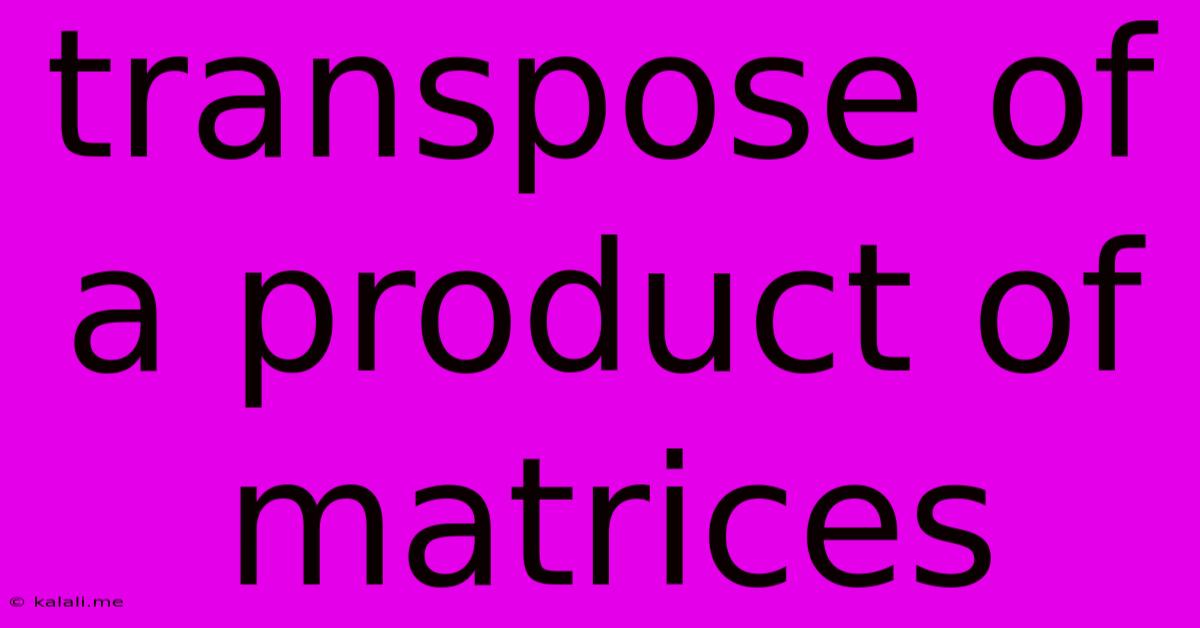Transpose Of A Product Of Matrices
Kalali
May 23, 2025 · 3 min read

Table of Contents
Transpose of a Product of Matrices: A Comprehensive Guide
This article explores the fascinating property of matrix transposition when applied to the product of matrices. Understanding this property is crucial for various linear algebra applications, including machine learning, computer graphics, and physics. We'll break down the concept, provide clear examples, and highlight its importance.
What is the Transpose of a Matrix?
Before diving into the product, let's refresh our understanding of the transpose. The transpose of a matrix, denoted as Aᵀ (or A<sup>T</sup>), is obtained by interchanging its rows and columns. In simpler terms, the first row becomes the first column, the second row becomes the second column, and so on.
For example, if:
A = [[1, 2], [3, 4]]
Then, Aᵀ = [[1, 3], [2, 4]]
The Transpose of a Product of Matrices
The core concept we'll explore is the relationship between (AB)ᵀ, the transpose of the product of matrices A and B, and the individual transposes of A and B. The key rule states:
(AB)ᵀ = BᵀAᵀ
This means the transpose of the product of two matrices is equal to the product of their transposes, but in reversed order. This reversal is crucial and often a source of confusion for beginners.
Proof (for the interested reader):
The proof involves considering the (i, j)th entry of both (AB)ᵀ and BᵀAᵀ and demonstrating their equivalence. Let's say A is an m x n matrix and B is an n x p matrix. Then:
- The (i, j)th entry of (AB)ᵀ is the (j, i)th entry of AB, which is Σ<sub>k=1</sub><sup>n</sup> a<sub>jk</sub>b<sub>ki</sub>.
- The (i, j)th entry of BᵀAᵀ is Σ<sub>k=1</sub><sup>n</sup> b<sub>kj</sub>a<sub>ik</sub>, which is the same as Σ<sub>k=1</sub><sup>n</sup> a<sub>jk</sub>b<sub>ki</sub>.
Since the (i, j)th entries are identical, (AB)ᵀ = BᵀAᵀ.
Examples to Illustrate the Concept
Let's solidify our understanding with some concrete examples.
Example 1:
A = [[1, 2], [3, 4]]
B = [[5, 6], [7, 8]]
AB = [[19, 22], [43, 50]]
(AB)ᵀ = [[19, 43], [22, 50]]
Bᵀ = [[5, 7], [6, 8]]
Aᵀ = [[1, 3], [2, 4]]
BᵀAᵀ = [[19, 43], [22, 50]]
As you can see, (AB)ᵀ = BᵀAᵀ.
Example 2 (with a non-square matrix):
A = [[1, 2, 3]]
B = [[4], [5], [6]]
AB = [[32]]
(AB)ᵀ = [[32]]
Bᵀ = [[4, 5, 6]]
Aᵀ = [[1], [2], [3]]
BᵀAᵀ = [[32]]
Again, the rule holds true.
Significance and Applications
The property (AB)ᵀ = BᵀAᵀ is fundamental in various applications:
- Efficient Computation: Calculating the transpose of a product can be computationally less expensive than computing the product first and then transposing the result, particularly for large matrices.
- Linear Regression: In linear algebra-based machine learning algorithms like linear regression, this property simplifies calculations related to matrix inversion and least squares solutions.
- Computer Graphics: Matrix transformations are fundamental in computer graphics. Understanding the transpose of matrix products helps in handling rotations, scaling, and translations efficiently.
Conclusion
The transpose of a product of matrices is a seemingly simple yet powerful concept with wide-ranging applications. Mastering this property and its proof enhances your understanding of linear algebra and its role in various fields. Remember the key takeaway: the order of the transposes is reversed in the resulting product. Practice with various examples to solidify your grasp of this important concept.
Latest Posts
Latest Posts
-
How Many Days In A Million Minutes
Jul 14, 2025
-
How Many Days Is In 11 Weeks
Jul 14, 2025
-
How Many Grams Are In One Tola Gold
Jul 14, 2025
-
How Many Oz In A Pound Of Freon
Jul 14, 2025
-
How Many Years Are In A Millennia
Jul 14, 2025
Related Post
Thank you for visiting our website which covers about Transpose Of A Product Of Matrices . We hope the information provided has been useful to you. Feel free to contact us if you have any questions or need further assistance. See you next time and don't miss to bookmark.